|
The Art of the Streets
by Bob Brooke
Posters are everywhere. They grace the walls of buildings inside and
out, advertising events and causes galore. Many of today’s posters
wouldn’t be considered art. They’re utilitarian announcements, some
commercially produced, others handmade. But they didn’t start out that
way.
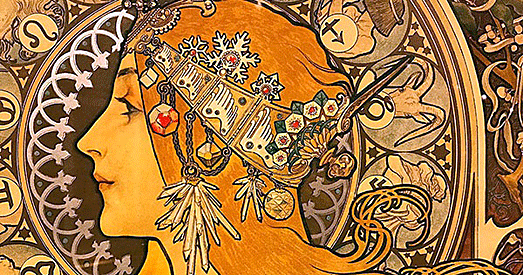
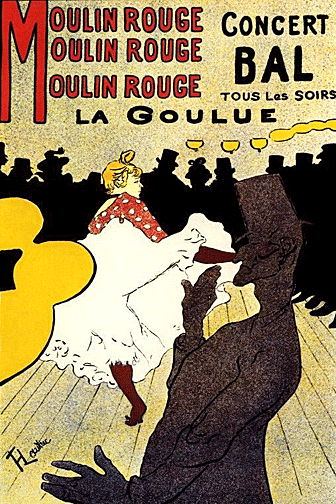 Originally,
many European artists, such as Jules Cheret , Henry Toulouse-Lautrec,
and Alphonse Mucha created posters. They used them to promote businesses
and political parties, recruit soldiers, advertise products and
generally spread ideas to the general public. Originally,
many European artists, such as Jules Cheret , Henry Toulouse-Lautrec,
and Alphonse Mucha created posters. They used them to promote businesses
and political parties, recruit soldiers, advertise products and
generally spread ideas to the general public.
The poster was one of the earliest forms of advertisement and began to
develop as a medium for visual communication in the early 19th century.
They influenced the development of typography because they were meant to
be read from a distance and required larger type to be produced, usually
from wood rather than metal.
The Birth of the Poster
Though lithography first appeared in 1798, for decades it was too slow
and expensive for poster production. Most posters continued to be simple
wood or metal
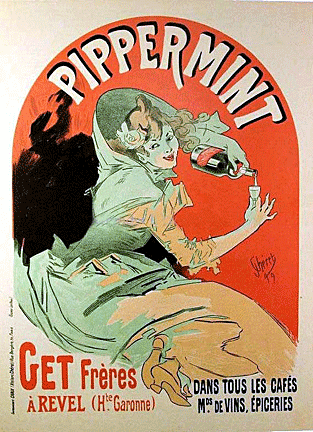 engravings
with little color or design. engravings
with little color or design.
In 1866 Jules Cheret started to produce color lithographic posters from
his own press in Paris. The form of the poster dates from this time.
This all changed around 1880 with Cheret's "three stone lithographic
process," a breakthrough which allowed artists to achieve every color
imaginable with as little as three stones—usually for one each of red,
yellow and blue—printed in careful registration.
Cheret's process demanded superb artistry and remarkable craftsmanship.
The result was a remarkable intensity of color and texture, with sublime
transparencies and nuances impossible in other media. The ability to
combine word and image in such an attractive and economical format
finally allowed the lithographic poster to usher in the modern age of
advertising. Over his 30-year career, Cheret created over 1,000 posters.
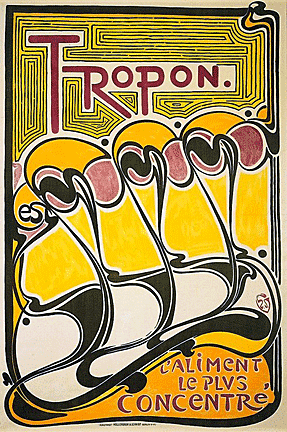 In
each country, artists used posters to celebrate the society's unique
cultural institutions. In France, it was the cafe and cabaret, in Italy
the opera and fashion, in Spain the bullfight and festivals, in Germany
trade fairs and magazines, in Britain and America literary journals,
bicycles, and the circus. In
each country, artists used posters to celebrate the society's unique
cultural institutions. In France, it was the cafe and cabaret, in Italy
the opera and fashion, in Spain the bullfight and festivals, in Germany
trade fairs and magazines, in Britain and America literary journals,
bicycles, and the circus.
Distinctive national styles also stood out. Dutch posters showed
restraint and orderliness, Italian posters drama and grand scale, German
posters directness and medieval influence.
Cheret studied at the Beaux-Arts in Paris while still working as a
lithographer's apprentice. In an interview with the English critic
Charles Hiatt, Cheret even maintained that for him posters were not
necessarily a good form for advertising but that they made excellent
murals.
This is the reason Cheret has become known as the first name in posters.
It isn’t that his designs are masterpieces of the art of advertising,
but that his posters, over a thousand of them, are magnificent works of
art. Instead of re-interpreting the great murals of the past for the
public of his day by creating large salon canvases, he found a new place
for his work—the street.
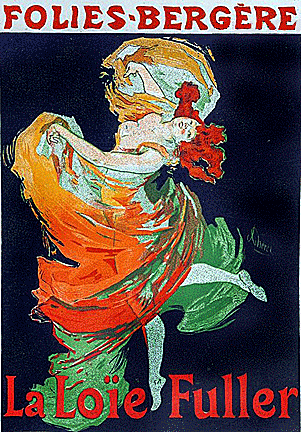 Part
of Paris had recently been re-designed by Baron Haussmann, the architect
of Napoleon Ill's new capital. In the place of some of the old buildings
in the city center, a new city of great style appeared. Cheret’s posters
found a home on the walls of some of the new buildings, and because of
this display of fine art in public places, posters became known as the
art gallery of the street. Part
of Paris had recently been re-designed by Baron Haussmann, the architect
of Napoleon Ill's new capital. In the place of some of the old buildings
in the city center, a new city of great style appeared. Cheret’s posters
found a home on the walls of some of the new buildings, and because of
this display of fine art in public places, posters became known as the
art gallery of the street.
Cheret took the visual language of popular folk art used to decorate
circus programs in the mid 1860s and enlarged it. The big American
advertisements for circuses from the United States on tour in England
during Cheret's stay there contributed to his ideas. The Americans
printed their posters in small sections using wood blocks. All these
elements contributed to the appearance of the poster, but it was without
doubt the effort of this one man that gave the poster its special
character.
Younger artists influenced by Cheret found that the poster developed a
form of visual shorthand in which ideas could be expressed simply and
directly—a way to convey the spirit of an era, a decorative comment on
the social life of the streets where his posters appeared.
Henri de Toulouse-Lautrec
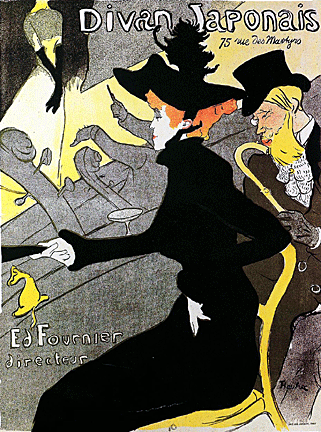 Henri
de Toulouse-Lautrec, on the other hand, used Cheret’s work to describe
what went on inside the lives of the inhabitants of those streets.
Lautrec went further by dramatizing his own personal experience and used
the medium of the poster as a means of expression. Thus the poster Divan
Japonais, created in 1893, is his portrait of a friend, Jane Avril. The
element of caricature, humorous and satirical, the simple, flat shapes
and the decorative line, were all devices that Lautrec could employ in a
poster but which he could not express so simply and directly in
painting. His posters have a quality of broad silhouette less apparent
in his paintings and drawings of the same subjects. Lautrec owes much of
his style to Cheret. Henri
de Toulouse-Lautrec, on the other hand, used Cheret’s work to describe
what went on inside the lives of the inhabitants of those streets.
Lautrec went further by dramatizing his own personal experience and used
the medium of the poster as a means of expression. Thus the poster Divan
Japonais, created in 1893, is his portrait of a friend, Jane Avril. The
element of caricature, humorous and satirical, the simple, flat shapes
and the decorative line, were all devices that Lautrec could employ in a
poster but which he could not express so simply and directly in
painting. His posters have a quality of broad silhouette less apparent
in his paintings and drawings of the same subjects. Lautrec owes much of
his style to Cheret.
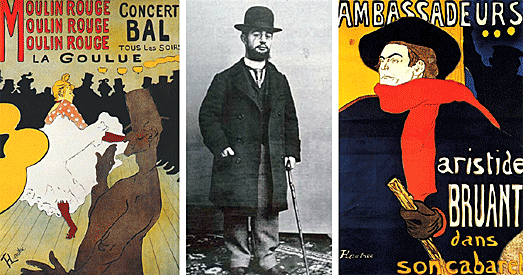
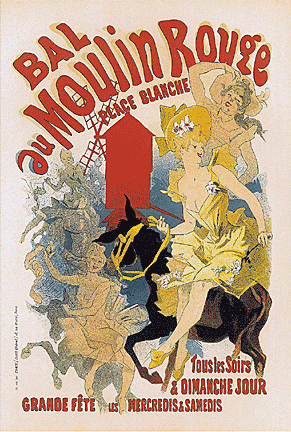 Cheret
designed the poster advertising the opening of the cabaret Moulin Rouge
in Montmarte in 1889. In 1891, Toulouse-Lautrec's extraordinary first
poster for the Moulin Rouge, featuring their new star La Gouloue,
elevated the status of the poster to fine art and touched off a poster
craze. During the 1890s, referred to as the La Belle Epoque in France,
poster exhibitions, magazines and dealers proliferated. The pioneering
Parisian dealer Sagot listed 2,200 different posters in his catalog. Cheret
designed the poster advertising the opening of the cabaret Moulin Rouge
in Montmarte in 1889. In 1891, Toulouse-Lautrec's extraordinary first
poster for the Moulin Rouge, featuring their new star La Gouloue,
elevated the status of the poster to fine art and touched off a poster
craze. During the 1890s, referred to as the La Belle Epoque in France,
poster exhibitions, magazines and dealers proliferated. The pioneering
Parisian dealer Sagot listed 2,200 different posters in his catalog.
Unfortunately, Lautrec’s posters weren’t very popular. His lithograph
Madmoiselle Marcelle Lender caused the resignation of its publishers
when they attempted to print the work. Lautrec's exhibition in London,
at the Goupil Galleries in 1898, was a failure. Even Yvette Guilbert,
the star of the show at the Divan Japonais, felt that the album Lautrec
had designed for her was too hideous to publish.
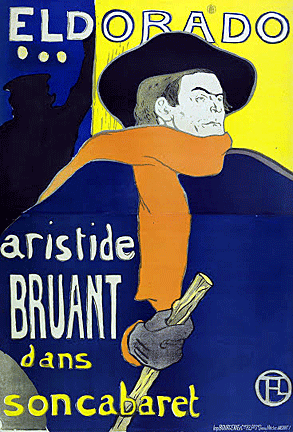 There’s
a sharp contrast between the posters of Cheret, aimed to please and
delight, and those of Lautrec which appeared to be ugly and
uncomfortable to view. There’s
a sharp contrast between the posters of Cheret, aimed to please and
delight, and those of Lautrec which appeared to be ugly and
uncomfortable to view.
However, the 31 posters Lautrec created during his short life of 37
years are a major contribution to the history of posters. Lautrec's
contribution to the 20th century was indirectly reflected in all poster
design, for he helped to establish the poster as an art form. One of his
best-known posters, Aristide Bruant, owner of the Paris cabaret Le Chat
Noir (The Black Cat) is a good example.
ART NOUVEAU POSTERS
The most characteristic modern art style of the turn of the 20th
century, Art Nouveau, included poster design. As a style, Art Nouveau
gave a decorative and ornamental value to linear patterns that were
often derived from natural shapes.
It represented, in decorative terms, new social developments, new
technology and new expressions of the spirit..
Pierre Bonnard
Among the most significant elements of Art Nouveau design, particularly
in Paris, were the shapes derived from the Japanese print. Some of these
designs had appeared on the wrapping paper of articles from the Far
East. The famous prints of artists such as Hiroshige, Hokusai and
Utamaro belonged to the Ukiyo-e School which included work that
described the daily life of the street. The Japanese print had a direct
influence on European poster design. Artists like Bonnard tried to
create original art without any model but nature, without any rule but
imagination and logic, using the French flora and fauna as details.
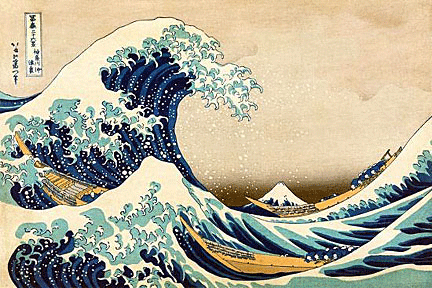
Alphonse Mucha
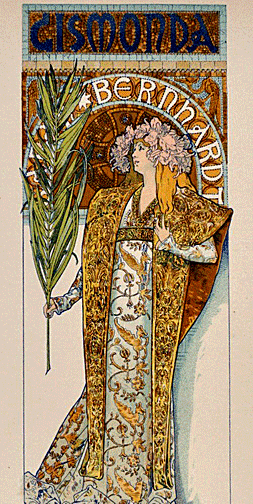 At
the turn of the 20th century, many artists believed that one art form
could and did affect the development of others, such as the poster. Thus
one of the best examples of the Art Nouveau poster is the work of
Alphonse Mucha. At
the turn of the 20th century, many artists believed that one art form
could and did affect the development of others, such as the poster. Thus
one of the best examples of the Art Nouveau poster is the work of
Alphonse Mucha.
Mucha was born in 1860 in the then Kingdom of Bohemia and eventually
traveled to Paris in 1890. His work went through a phase of Art Nouveau
expression, during which he designed posters in the fashionable
“Byzantine” style of ornamentation. He later left Paris in order to live
for a short time in New York and finally changed the style of his work
to become a painter of Slavic themes on the grand scale.
Mucha's best-known posters are those associated with Sarah Bernhardt.
She was responsible for commissioning him to make his first successful
poster, Gismonda, in 1894, which made his name in Paris. As a painter of
the Bernhardt myth, Mucha proved to be her perfect counterpart. He
accompanied her to New York and his work was introduced to another
world.
Just three years later, Mucha created his first masterpiece of Art
Nouveau poster design. Bearing multiple influences including the
Pre-Raphaelites, the Arts and Crafts Movement, and Byzantine art, this
flowering, ornate style became the major international decorative art
movement until the beginning of World War I.
Learn about current prices for art posters by reading "Early
Art Posters Rock the Auction Block."
< Back
to Collectibles Archives
Next Article > |
